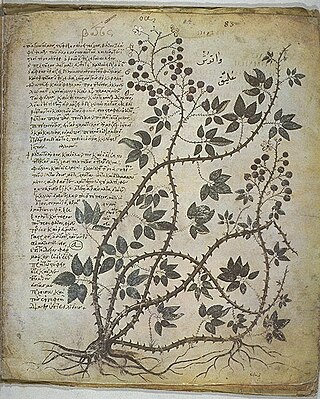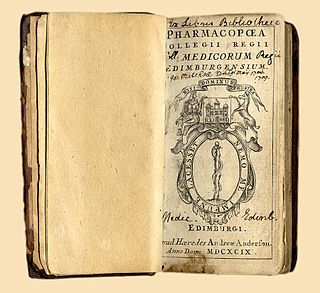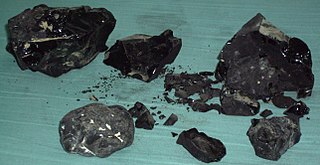
Pedanius Dioscorides, "the father of pharmacognosy", was a Greek physician, pharmacologist, botanist, and author of De materia medica, a 5-volume Greek encyclopedia about herbal medicine and related medicinal substances, that was widely read for more than 1,500 years. For almost two millennia Dioscorides was regarded as the most prominent writer on plants and plant drugs.

Materia medica is a Latin term from the history of pharmacy for the body of collected knowledge about the therapeutic properties of any substance used for healing. The term derives from the title of a work by the Ancient Greek physician Pedanius Dioscorides in the 1st century AD, De materia medica, 'On medical material'.

A pharmacopoeia, pharmacopeia, or pharmacopoea, in its modern technical sense, is a book containing directions for the identification of compound medicines, and published by the authority of a government or a medical or pharmaceutical society.

In the history of medicine, "Islamic medicine" Also known as "Arabian medicine" is the science of medicine developed in the Middle East, and usually written in Arabic, the lingua franca of Islamic civilization.

Storax, often commercially sold as styrax, is a natural resin isolated from the wounded bark of Liquidambar orientalis Mill. and Liquidambar styraciflua L. (Hamamelidaceae). It is distinct from benzoin, a similar resin obtained from the Styracaceae plant family.

Balm of Gilead was a rare perfume used medicinally that was mentioned in the Hebrew Bible and named for the region of Gilead, where it was produced. The expression stems from William Tyndale's language in the King James Bible of 1611 and has come to signify a universal cure in figurative speech. The tree or shrub producing the balm is commonly identified as Commiphora gileadensis. However, some botanical scholars have concluded that the actual source was a terebinth tree in the genus Pistacia.

Bdellium is a semi-transparent oleo-gum resin extracted from Commiphora wightii plants of India, and from Commiphora africana trees growing in sub-saharan Africa. According to Pliny the best quality came from Bactria. Other named sources for the resin are India, Arabia, Media, and Babylon.

Diyāʾ al-Dīn Abū Muḥammad ʿAbd Allāh ibn Aḥmad al-Mālaqī, commonly known as Ibn al-Bayṭār was an Andalusian Arab physician, botanist, pharmacist and scientist. His main contribution was to systematically record the additions made by Islamic physicians in the Middle Ages, which added between 300 and 400 types of medicine to the one thousand previously known since antiquity. He was a student of Abu al-Abbas al-Nabati.

Mummia, mumia, or originally mummy referred to several different preparations in the history of medicine, from "mineral pitch" to "powdered human mummies". It originated from Arabic mūmiyā "a type of resinous bitumen found in Western Asia and used curatively" in traditional Islamic medicine, which was translated as pissasphaltus in ancient Greek medicine. In medieval European medicine, mūmiyā "bitumen" was transliterated into Latin as mumia meaning both "a bituminous medicine from Persia" and "mummy". Merchants in apothecaries dispensed expensive mummia bitumen, which was thought to be an effective cure-all for many ailments. It was also used as an aphrodisiac.

The history of pharmacy as a modern and independent science dates back to the first third of the 19th century. Before then, pharmacy evolved from antiquity as part of medicine. The history of pharmacy coincides well with the history of medicine, but it's important that there is a distinction between the two topics. Pharmaceuticals is one of the most-researched fields in the academic industry, but the history surrounding that particular topic is sparse compared to the impact its made world-wide. Before the advent of pharmacists, there existed apothecaries that worked alongside priests and physicians in regard to patient care.

The Leyden papyrus X is a papyrus codex written in Greek at about the end of the 3rd century A.D. or perhaps around 250 A.D. and buried with its owner, and today preserved at Leiden University in the Netherlands.
Ahmad bin Muhammad bin Mufarraj bin Ani al-Khalil, better known as Abu al-Abbas al-Nabati, Ibn al-Rumiya or al-Ashshab, was an Andalusian scientist, botanist, pharmacist and theologian. He was a teacher of fellow Andalusian botanist Ibn al-Baitar.
The Baghdad School, also known as the Arab school, was a relatively short-lived yet influential school of Islamic art developed during the late 12th century in the capital Baghdad of the ruling Abbasid Caliphate. The movement had largely died out by the early 14th century, five decades following the invasion of the Mongols in 1258 and the downfall of the Abbasids' rule, and would eventually be replaced by stylistic movements from the Mongol tradition. The Baghdad School is particularly noted for its distinctive approach to manuscript illustration. The faces depicted in illustrations were individualized and expressive, with the scenes often highlighting realistic features of everyday life from the period. This stylistic movement used strong, bright colors, and employed a balanced sense of design and a decorative quality, with illustrations often lacking traditional frames and appearing between lines of text on manuscript pages.

The Physician Preparing an Elixir is a miniature on a folio from an illustrated manuscript copy, now in the Metropolitan Museum of Art in New York of De Materia Medica, a large herbal or work on the (mostly) medical uses of plants originally written by the ancient Greco-Roman physician, Pedanius Dioscorides, in the first century AD. This page of the manuscript, dated 1224 AD, is made from paper, sized 24.8 cm wide and 33.2 cm long, and is decorated by opaque watercolor, ink, and gold detailing. It is visually split into three horizontal portions from the top of the page to the bottom; the top of the page is dominated by two lines of Arabic script, followed by the image and then five more lines of text in Arabic. The writing below the image is predominantly black with the exception of one line, which is written in red ink and is therefore highlighted to the viewer. The page is usually not on display.

Theophrastus's Enquiry into Plants or Historia Plantarum was, along with his mentor Aristotle's History of Animals, Pliny the Elder's Natural History and Dioscorides's De materia medica, one of the most important books of natural history written in ancient times, and like them it was influential in the Renaissance. Theophrastus looks at plant structure, reproduction and growth; the varieties of plant around the world; wood; wild and cultivated plants; and their uses. Book 9 in particular, on the medicinal uses of plants, is one of the first herbals, describing juices, gums and resins extracted from plants, and how to gather them.

De materia medica is a pharmacopoeia of medicinal plants and the medicines that can be obtained from them. The five-volume work was written between 50 and 70 CE by Pedanius Dioscorides, a Greek physician in the Roman army. It was widely read for more than 1,500 years until supplanted by revised herbals in the Renaissance, making it one of the longest-lasting of all natural history and pharmacology books.

Opopanax is a genus of plants in the family Apiaceae.

Sagapenum is a historical plant from Media, identified with Ferula persica and Ferula szowitziana, also denoting its yellow translucent resin, which causes irritation of the skin and whose smell resembles that of asafoetida.
The incense offering, a blend of aromatic substances that exhale perfume during combustion, usually consisting of spices and gums burnt as an act of worship, occupied a prominent position in the sacrificial legislation of the ancient Hebrews.
Chrysocolla, also known as "goldsmith's solder" and "solder of Macedonia" (Pseudo-Democritus), denotes:

















